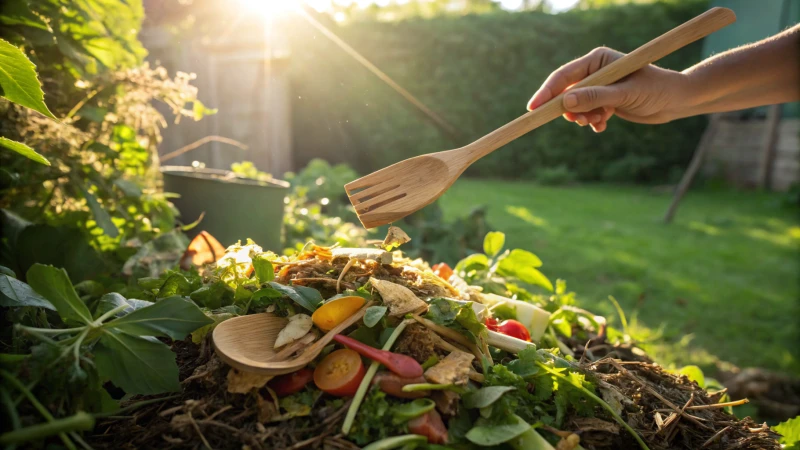
Discovering how to dispose of wooden cutlery responsibly can help us all play a part in protecting our planet.
Wooden cutlery is best disposed of by composting since it's biodegradable and breaks down into organic material. If local recycling facilities accept wood, recycling is another option to reduce waste.
I remember the first time I realized just how much single-use items contribute to environmental waste. I was hosting a small family gathering, and after everyone left, I stared at a pile of disposable cutlery, feeling guilty. That's when I decided to explore more sustainable alternatives like wooden cutlery. Composting seemed like a straightforward solution, but I wanted to learn more about recycling options too.
Composting is nature's way of recycling. It's a simple process where wooden cutlery can break down naturally, returning nutrients back to the earth. This method reduces landfill waste and helps nourish the soil, making it an excellent choice for those who want to tread lightly on the planet. Alternatively, if your local recycling center accepts wood, you can recycle your cutlery there. It's always worth checking their guidelines as they vary by location.
Incorporating these practices into my routine has been an eye-opener. Not only do they align with my values, but they also spark interesting conversations about sustainability with friends and family. By understanding and applying these eco-friendly methods, we can all contribute to a greener future.
Wooden cutlery can be composted.True
Wooden cutlery is biodegradable and breaks down into organic material.
Recycling facilities commonly accept wooden cutlery.False
Most recycling facilities do not accept wood due to processing limitations.
How Does Composting Wooden Cutlery Benefit the Environment?
Picture this: a world where even our cutlery helps save the planet. Sounds dreamy, right?
Composting wooden cutlery helps the environment by cutting down landfill waste, slashing our carbon footprint, and boosting soil health. Unlike plastic, these utensils break down naturally and enrich the earth with nutrients.
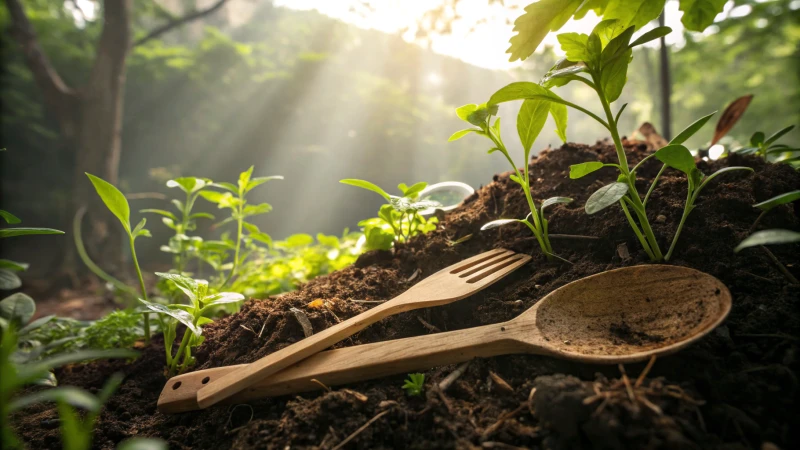
How Composting Wooden Cutlery Reduces Waste
Let me share a small win from my own life. A while back, I made a conscious choice to swap out plastic for wooden cutlery at our family picnics. It was a simple switch, but knowing those utensils would decompose in months rather than centuries felt like I was doing my bit for the planet. It's fascinating to see how something as small as a fork can lessen the strain on our waste systems and help reduce greenhouse gas emissions1.
| Material | Decomposition Time | Environmental Impact |
|---|---|---|
| Plastic | Hundreds of years | High |
| Wood | Few months | Low |
Enhancing Soil Health through Nutrient Recycling
I remember planting a tiny herb garden on my windowsill and using composted material to nourish it. Just like how that compost enriched my basil and mint, when wooden cutlery is composted, it turns into nutrient-rich humus, boosting soil fertility with essential nutrients like nitrogen and phosphorus. This cycle not only strengthens the soil but also supports sustainable agriculture—it's like giving nature a helping hand.
Reducing Carbon Footprint with Biodegradable Materials
Switching to wooden cutlery is also about reducing our carbon footprint. Think about this: the energy used to create and dispose of plastic cutlery is massive. By choosing wood, we’re opting for materials from renewable sources that use less energy in production and decomposition. Composting them means they transform into organic matter, aligning with global efforts to combat climate change2.
Encouraging Eco-Conscious Consumer Behavior
It’s heartening to see businesses promoting eco-friendly practices by switching to compostable wooden cutlery. They’re not just reducing reliance on plastics but also educating consumers about sustainable disposal methods. I’ve noticed more cafes and restaurants in my area are doing this, and it really enhances their brand image while appealing to customers who care about the planet.
Benefits Summary:
- Waste Reduction: Minimizes landfill contributions.
- Soil Enrichment: Provides nutrients for healthier soils.
- Carbon Footprint Reduction: Lowers emissions compared to plastic.
- Consumer Awareness: Promotes sustainable habits among users.
Through these actions, composting wooden cutlery becomes a simple yet powerful way to champion environmental health, making it part of our collective journey toward sustainability.
Composting wooden cutlery reduces landfill waste.True
Wooden cutlery decomposes quickly, minimizing landfill contributions.
Plastic cutlery enhances soil health when composted.False
Plastic does not decompose into nutrients beneficial for soil health.
Can Wooden Cutlery Be Recycled?
I remember the first time I switched from plastic to wooden cutlery—it felt like a small but significant step towards saving our planet. But can we really recycle these eco-friendly utensils?
Yes, wooden cutlery can be recycled, but it depends on whether they are coated or untreated. Untreated wooden utensils are often compostable, while those with coatings may need specialized recycling facilities.
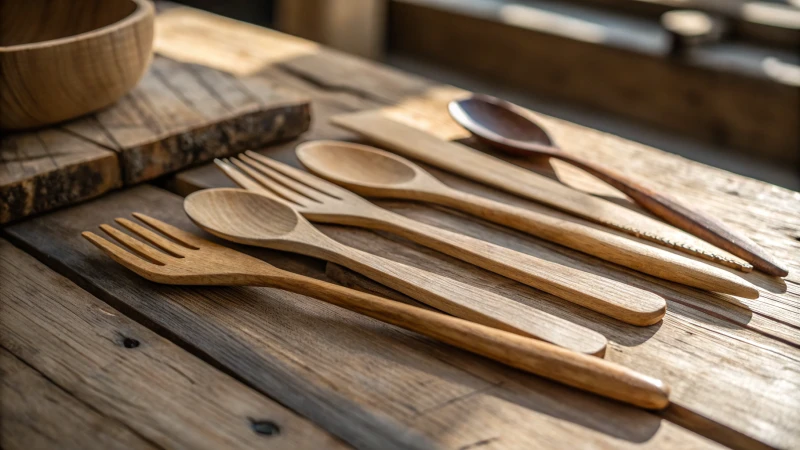
Understanding the Composition of Wooden Cutlery
You know, back when I first started using wooden cutlery, I had no idea there was more to it than just being 'wooden.' These utensils are typically crafted from natural wood, but often, they're treated with varnishes or other coatings for durability.
| Component | Recyclability |
|---|---|
| Untreated Wood | Compostable3, recyclable in some regions |
| Treated Wood | Specialized recycling required |
The beauty of wooden cutlery lies in its natural composition, making it a great option for composting when untreated. However, those pesky coatings like lacquer can make things a bit tricky.
Recycling vs. Composting: Which is Better?
Deciding between recycling and composting feels like choosing between two great options at a restaurant—both are good, but one might just hit the spot better depending on your local facilities. Composting untreated wooden cutlery is usually a breeze in most places. Recycling, however, might require a bit more effort, especially if your cutlery has been treated.
- Recycling: It's the go-to for treated wood but requires those specialized facilities.
- Composting: Perfect for untreated cutlery and does wonders for enriching the soil health4.
By composting untreated wooden cutlery, not only are you managing waste better, but you're also giving back to soil health.
Exploring Eco-Friendly Disposal Methods
Beyond recycling, I've found it’s worth exploring other eco-friendly disposal methods. For instance, home composting5 can effectively break down untreated wooden utensils. Some local authorities also offer guidance on disposing of coated wooden cutlery responsibly.
| Disposal Method | Suitable For |
|---|---|
| Home Composting | Untreated Wood |
| Specialized Recycling | Treated Wood |
| Municipal Compost Facilities | Both types (with guidelines) |
Practical Tips for Consumers
Over time, I’ve picked up a few practical tips to ensure my wooden cutlery is disposed of responsibly:
- Check for Coatings: Take a moment to see if your cutlery is treated or untreated.
- Research Local Facilities: Look into what your local recycling or composting options are.
- Engage with Suppliers: Choose suppliers who provide clear information on sustainability and disposal methods.
By making these informed choices and nudging suppliers towards greater transparency, we can all play a part in reducing our environmental impact when using disposable wooden cutlery.
Untreated wooden cutlery is compostable.True
Untreated wooden cutlery can be composted, enriching soil health.
All wooden cutlery can be recycled easily.False
Treated wood requires specialized recycling, complicating the process.
What Are the Disposal Differences Between Wooden and Plastic Cutlery?
Every time I reach for a fork, I wonder about its journey after I'm done. Is it destined to haunt our planet for centuries, or will it gently return to nature?
Wooden cutlery wins the eco-friendly race by being biodegradable and compostable, seamlessly blending back into the earth. On the other hand, plastic cutlery clogs landfills, taking centuries to decompose and harming ecosystems in the process.
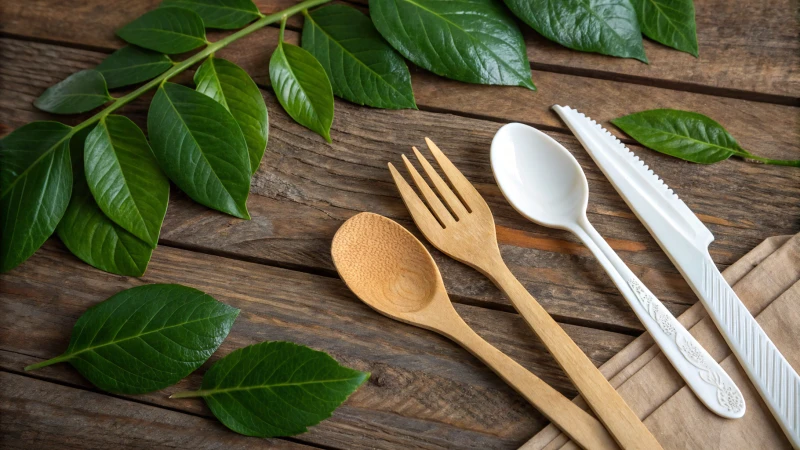
Biodegradability and Compostability
I remember the first time I learned about composting; it was like discovering a hidden secret of nature. Wooden cutlery fits perfectly into this narrative. It breaks down naturally, enriching the soil rather than burdening it. Composting facilities6 have become more common, allowing us to turn waste into a valuable resource effortlessly. In stark contrast, plastic cutlery clings to existence, refusing to decompose for hundreds of years.
Environmental Impact
The environmental impact of my disposal choices hit home during a beach cleanup. Seeing plastic litter everywhere was eye-opening. Wooden cutlery, when disposed of responsibly, disappears within months, aligning with sustainable practices. But plastics? They linger, contributing to the growing menace of landfills7 and marine pollution. This clear difference makes wooden cutlery my go-to for a cleaner conscience and a healthier planet.
Recyclability Challenges
Recycling often feels like navigating a complex puzzle, especially with plastic cutlery. The food contamination makes it nearly impossible to recycle effectively. Meanwhile, wooden cutlery’s natural makeup allows it to slip easily into recycling streams8 or compost sites. It's a key advantage in managing disposal without the headache.
Comparative Table: Disposal Options
| Feature | Wooden Cutlery | Plastic Cutlery |
|---|---|---|
| Biodegradable | Yes | No |
| Time to Decompose | Months | Hundreds of years |
| Compostable | Yes | No |
| Recycling Challenges | Minimal | High |
| Environmental Impact | Positive | Negative |
This comparison highlights why I've chosen wooden cutlery over plastic for sustainable living. The move towards eco-friendly options is not just a trend; it's a necessary step for preserving our planet. Every small choice counts in the big picture of sustainability.
Wooden cutlery decomposes within months.True
Wooden cutlery naturally breaks down in compost, enriching soil health.
Plastic cutlery is easily recyclable.False
Plastic cutlery often contaminates recycling, complicating the process.
How Can Wooden Cutlery Be Disposed of Successfully?
Ever wondered how wooden cutlery disposal can be both eco-friendly and innovative? Dive into these real-life success stories that show how businesses are transforming waste into something valuable.
Successful wooden cutlery disposal involves composting, recycling, and community initiatives. Case studies from eco-conscious businesses illustrate how these strategies reduce landfill waste and enhance environmental sustainability.
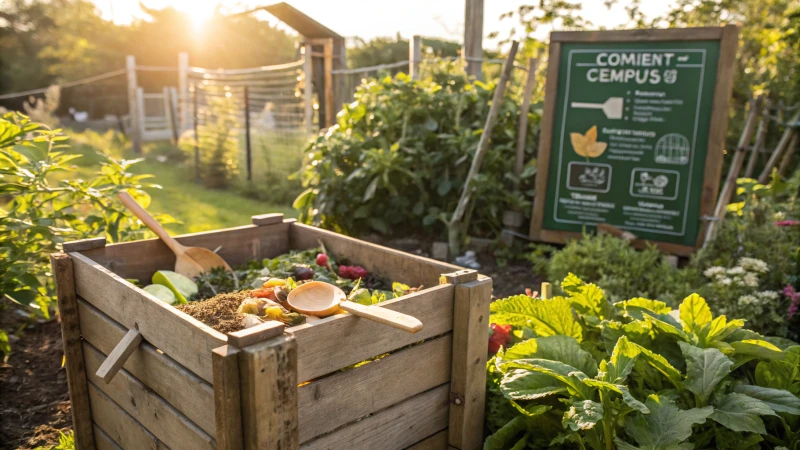
Growing up, I remember the piles of plastic cutlery that filled our kitchen drawers after every family gathering. The thought of it heading straight to landfills used to bother me. That's why I'm thrilled to share how some businesses are changing the game with wooden cutlery disposal.
Composting: Turning Waste into Resource
Composting wooden cutlery is like giving back to the Earth. I recall visiting a food festival where EcoDine's GreenPlate Initiative9 had set up composting stations. Watching people actively sort their waste made me realize how simple actions can significantly reduce landfill contributions.
Recycling Innovations in Hospitality
The creative reuse of materials has always fascinated me. At HotelEco, they took recycling to the next level by involving local artists to transform used cutlery into artistic décor. This artistic repurposing10 wasn't just about recycling; it was about community engagement and adding cultural value to what was once considered waste.
Community-Led Disposal Programs
Education is powerful. In Australia, I heard about the Sustainable Café Project11, where local councils and cafes teamed up to teach proper disposal practices. The project saw a 30% decrease in non-biodegradable waste over six months—proof that informed communities make a difference.
Comparative Analysis of Methods
| Method | Advantages | Challenges |
|---|---|---|
| Composting | Reduces landfill waste, enriches soil | Requires dedicated composting facilities |
| Recycling | Promotes creative reuse, engages community | Collection logistics can be complex |
| Community-Led | Increases public awareness, supports local economy | Relies on sustained community interest |
These examples show that with creativity and commitment, disposing of wooden cutlery can be more than just trash management—it's a step toward a sustainable future. Inspired by these stories, I'm keen on finding ways to implement similar solutions that match my sustainability goals.
Composting reduces landfill waste by 50%.False
While composting reduces landfill waste, the exact percentage can vary.
HotelEco's recycling program involves local artists.True
HotelEco engaged local artists for artistic repurposing of cutlery.
Conclusion
Wooden cutlery is eco-friendly, compostable, and biodegradable. Composting reduces landfill waste and enriches soil, while recycling options depend on treatment; both methods support sustainability efforts.
-
Learn how composting wooden cutlery helps reduce harmful greenhouse gases, contributing to a healthier planet. ↩
-
Explore the role of biodegradable materials like wooden cutlery in lowering carbon emissions. ↩
-
Explore this link for detailed methods on composting untreated wooden cutlery effectively at home or in community composts. ↩
-
Learn how composting enhances soil health by providing nutrients and improving soil structure, contributing to sustainable gardening. ↩
-
This guide offers step-by-step instructions on starting a home compost pile, perfect for managing household waste sustainably. ↩
-
Learn how composting facilities process wooden cutlery, turning waste into valuable resources. ↩
-
Understand the long-term environmental effects of plastic cutlery ending up in landfills. ↩
-
Explore why recycling plastic cutlery is difficult and its impact on waste management. ↩
-
Learn how EcoDine's GreenPlate Initiative innovatively uses composting to reduce landfill waste at events. ↩
-
Discover how HotelEco turns recycled cutlery into art, merging sustainability with creativity. ↩
-
Explore how Australian cafés educate patrons on sustainable disposal practices effectively. ↩

